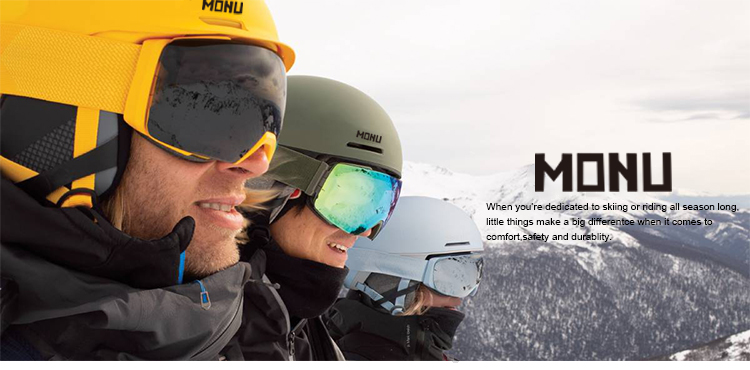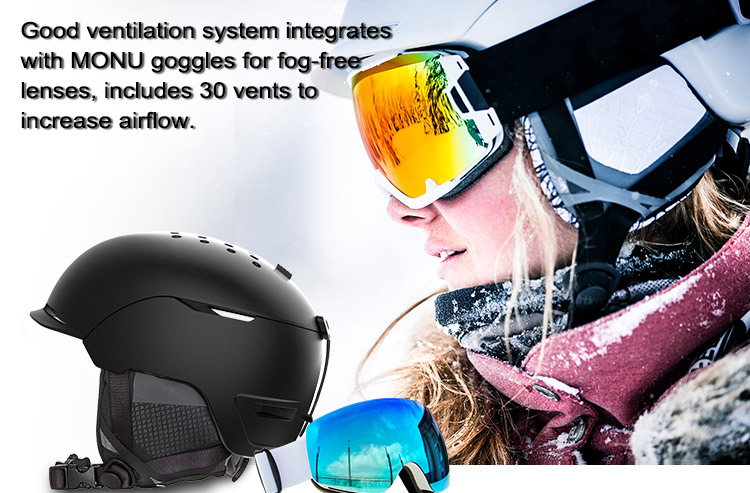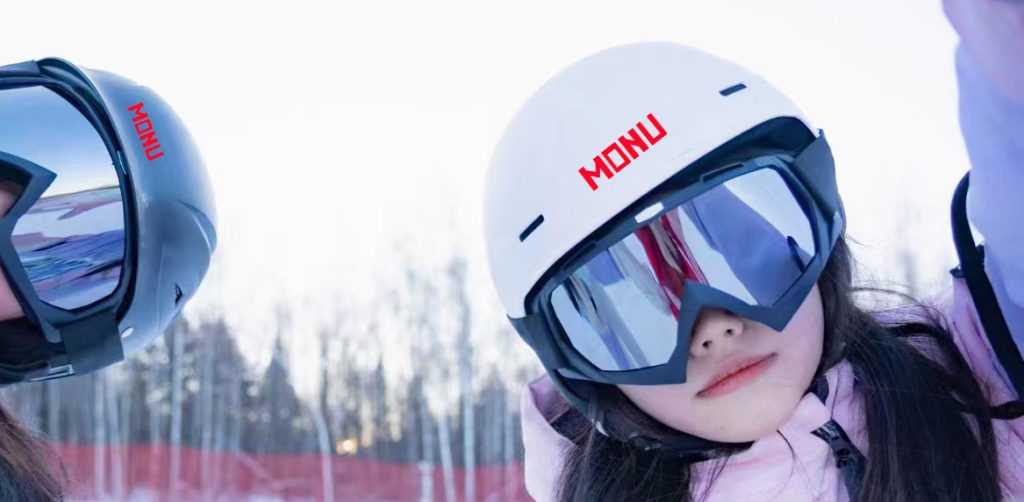Methods & Importance | Choosing a Ski Helmet for Harbin Trip

Harbin International Ice and Snow Festival attracts a large number of tourists every year. Skiing has become one of the must-do activities in Harbin. A ski helmet is a prerequisite for safety. At MONU SPORTS at booth E1.170 at ISPO BEIJING 2024, choose the right ski helmet for maximum safety and protection
1. How to choose a ski helmet for Harbin trip?
Everyone knows the function of helmets, but the effects of helmets worn by different sports are also different. For skiing, what is the most important thing, hardness? wrong. The most important thing about ski helmets is shock absorption, followed by hardness. Criteria for choosing a helmet. It is especially important to choose a helmet that suits your head shape. The selection of a helmet depends on 3 important criteria: – Size – Comfort – Breathability
1.1 Size:
A helmet must fit snugly against the head to provide effective protection.
Therefore, the first step is to measure the circumference of your head. Here’s how to measure: Take a measuring tape and wrap it around your head above your ears/eyebrows.
The figures you get are usually between 52cm and 65cm.
Markings vary from manufacturer to manufacturer, but the following size standards are generally used:
| Head Circumference | Helmets Sie |
| 55-56 cm | S |
| 57-58cm | M |
| 59-60 cm | L |
| 60-61cm | XL |
1.2 Comfort:
Helmet with innovative technology specially designed for skiing and snowboarding, combining performance and lightness. Enjoy maximum protection while ensuring your freedom of movement.

There are two types of ski helmets for your Harbin trip:
1.Classic helmet with two layers:
a hard protective outer shell protects the head against hard objects, and an inner layer absorbs shock
2.One-piece helmet, where the outer shell and shock-absorbing layer are fused together to form a one-piece shell for extra lightness.
1.3. Breathable:
Some helmets have vents and adjustable ventilation systems to help you regulate your temperature and wick away sweat.
To avoid drafts, check the helmet and visor for air.
There are various ventilation modes to choose from or adjust:
- Air Cooling System with 6 ventilation holes for continuous breathability.
- The Air Block has 10 or 12 ventilation holes for excellent breathability. The vents can be closed.
- Active Air Cooling System can adjust ventilation settings.
2. 10 Safety Myths About Ski Helmet for Harbin Use
2.1 Myth 1: The lighter the ski helmet, the better
Relatively speaking, the lighter the ski helmet, the better. But the lighter the cycling helmet, the less chance it will have to test the test standards of national safety certification, and the higher the relative price. Therefore, the premise of choosing a helmet must pass the test standards of national safety certification, most helmets above 200 yuan can achieve about 260G, this weight will not make you feel tired even if it is long-distance, so do not care too much about the weight index of the helmet. Unless you’re in order to race a bike. Keep your weight as low as possible, otherwise it’s not worth spending extra money on a lightweight helmet.
2.2 Myth 2: The larger or more holes the helmet, the more breathable
Breathability is key to helmets that keep your head dry on long rides. The more or larger the ventilation holes on your helmet, the greater the airflow around your head and the cooler you feel. However, keep in mind that the more or larger the ventilation holes on your helmet, the more your head is exposed, so the protection is reduced. Road bike helmets have more or larger ventilation holes than mountain bike helmets. Similarly, road cyclists consider the weight of their helmets more than mountain bikers. In general, the lighter the helmet, the more expensive it is. So, unless you’re racing and trying to keep your weight as light, it’s not worth the extra money to buy a lightweight ski helmet.
2.3 Myth 3: Buckles and pull straps cannot withstand a certain amount of force
You may only know that cycling helmets need to do some crash tests, but buckles and straps must also be tested accordingly, and if they do not pass the corresponding pull tests, they cannot be used on helmets. Therefore, a qualified cycling helmet, small buckles and straps must pass the corresponding tests, in order to be regarded as a helmet that meets the national safety certification test standards in the true sense of a person.
2.4 Myth 4: Ski Helmet is broken or used beyond the expiration date
If it is cracked, it cannot be used, there is not much substantial use, if it is small bumps do not matter, but once the crash, the force is large, it may not be able to play a protective role. Don’t underestimate a crack, it has already physically changed the force and force component effect of the helmet. Regardless of whether they have fallen or collided, cyclists should change their cycling helmets every three years. Because, although the helmet has not been impacted, the exposure to sunlight and sweat erosion will also cause the helmet and some accessories to age, thereby weakening the safety factor and damaging the protective performance of the ski helmet, especially in such cold places like Harbin.
2.5 Myth 5: Wear a ski helmet without a belt
It may be more comfortable to undo the jawband of the helmet, but if the head is hit, it will easily bounce out, and naturally it will not be protective. So for the protection of the helmet, wear a helmet jawband at all times.
2.6 Myth 6: Wear ski helmets that are too wide or narrow for Harbin Skiing
If the ski helmet is not the right size, it will not protect your head from being hit, do not make the mistake of buying a helmet of the wrong size. To determine the correct size of the helmet, measure around the largest part of the head (usually 1 cm above the eyebrows) and then buy the helmet according to this measurement. Since helmets tend to come in small, medium, and large sizes, you may only buy one that is relatively suitable and then use the size adjuster rotary button to adjust it to the best size. After putting on the helmet, turn the helmet from side to side, from front to back, feel comfortable to wear, if it is too loose or too tight, you need to continue to adjust or replace it.

2.7 Myth 7: Use inferior ski helmets for your Harbin trip
The manufacture of ski helmets in China has strict technical standards, and inferior helmets often fail to meet safe anti-collision standards and cause danger. Many skiing enthusiasts in Harbin may not know how to know whether the helmet they bought back is safe, in fact, simply from whether the helmet is affixed with CE certification can not determine whether the helmet is safe, there must also be a corresponding test report and certification certificate. CE marking certification is a product-specific certification that focuses on the safety features of the product. It is a certificate of conformity that reflects the product’s requirements for public safety, hygiene, environmental and personal safety.
2.8 Myth 8: The wearing position is incorrect
The most effective helmet position requires keeping the helmet and head level, and the edge of the helmet should be about 1 cm above the eyebrows. If it is not in this position, check that the helmet is the right size, and then adjust the adjuster knob and jaw strap to make sure the helmet is in the correct position.
2.9 Myth 9: The tie is loose
The loose straps allow the helmet to jump and move at any time, and when the head is hit, it will be hit twice, so that the protection effect is reduced. Therefore, it is necessary to adjust the length of the strap so that the distance between the strap and the chin is adjusted to a gap between the fingers, which can maximize the effective safety protection performance of the helmet.
2.10 Myth 10: Cycling helmets are placed casually after use
After each use of the helmet, please store it in a cool and ventilated place to avoid high temperatures or prolonged sunlight.